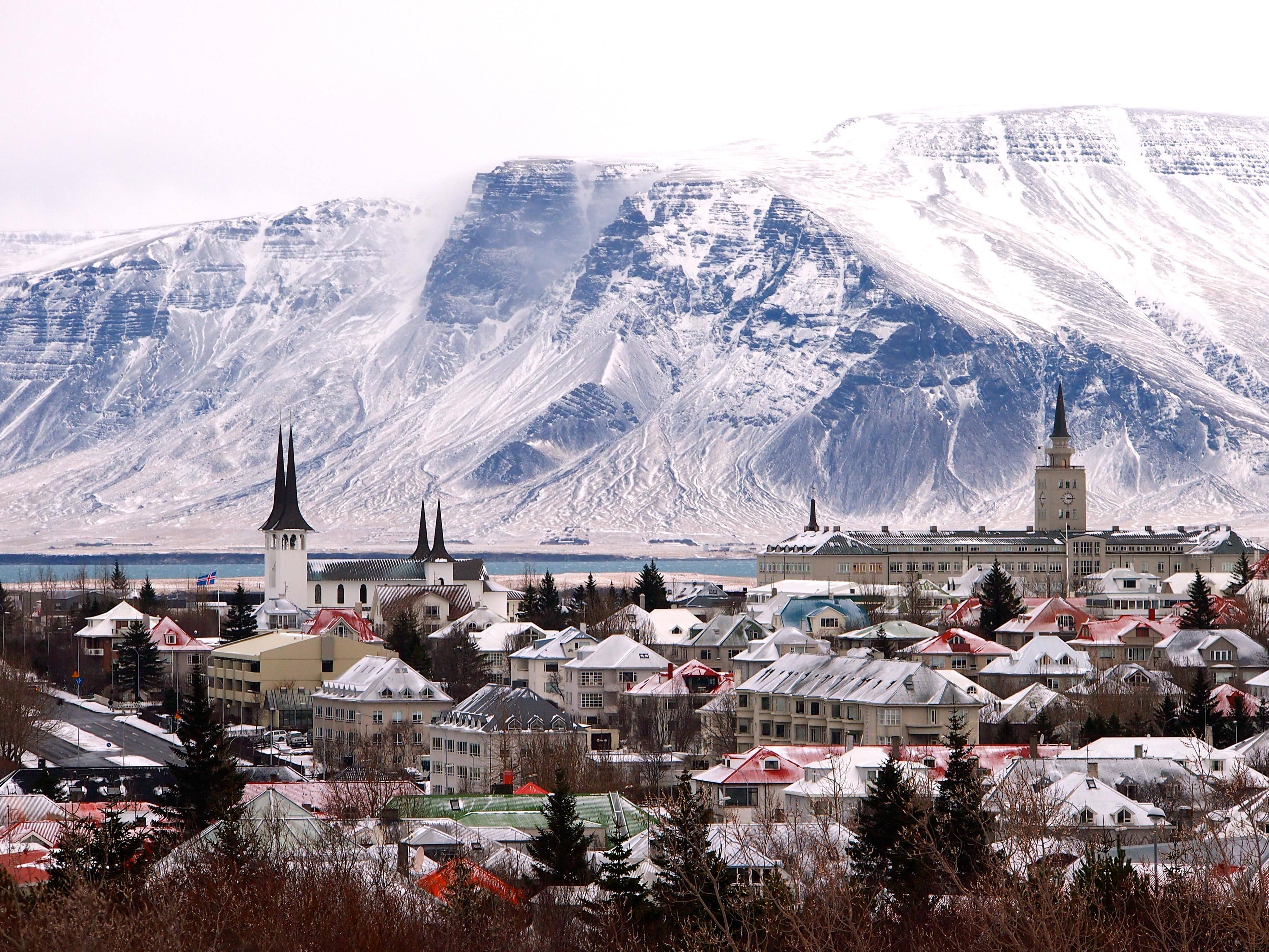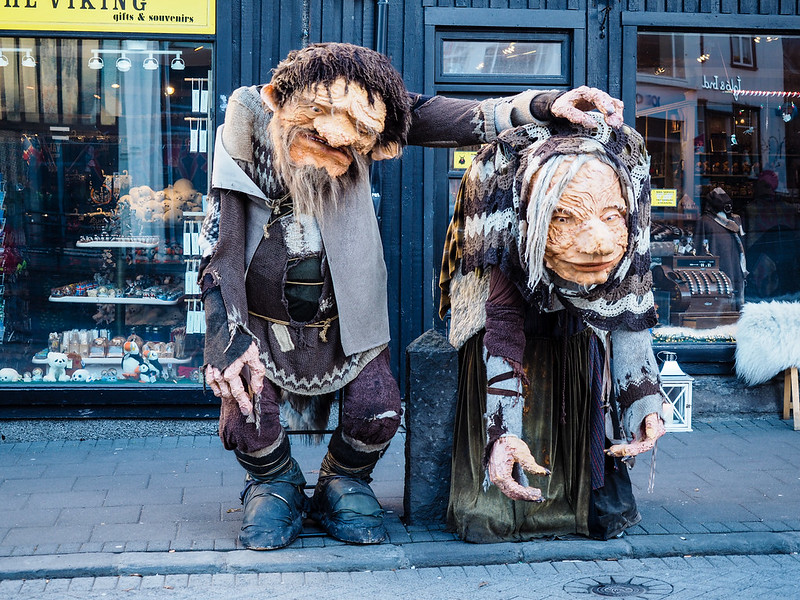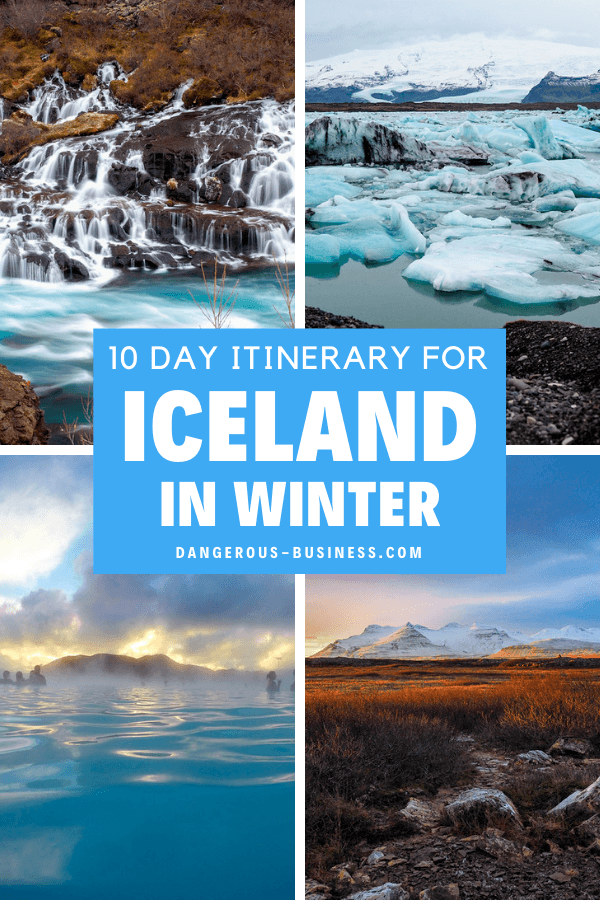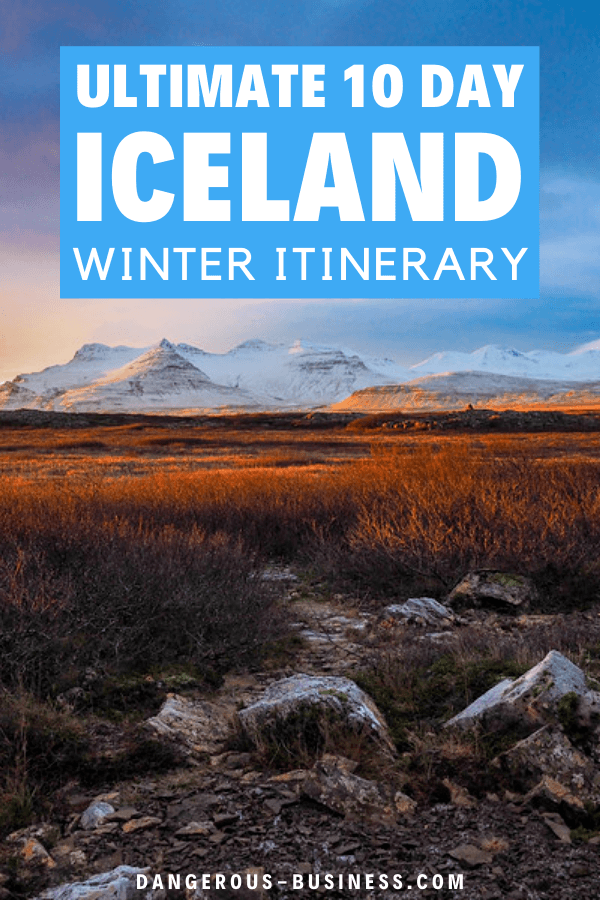A 10-Day Itinerary for Iceland in Winter (Without Renting a Car)

The country of Iceland has shot from relative obscurity to bucket list favorite in the last couple of years, catapulting it to the top of many travel wish lists and causing tourism numbers to skyrocket.
And this is well-deserved – Iceland is an incredible, magical country.
A lot of people who write about traveling to Iceland write about visiting in the summer months, when the days are long, the weather mild, and the Ring Road fully open for driving. In fact, driving Iceland's Ring Road is probably the most popular thing to do in the country, trip-wise.
But guess what? Iceland in the winter is awesome, too. The weather isn't *too* cold, most of the main attractions are still open, and prices are generally a little lower since there aren't as many people visiting.
In fact, I highly recommend going to Iceland in winter over any other time of year!
RELATED: Things No One Tells You About Iceland in Winter
A lot of people who head to Iceland in winter worry about one main thing: driving on roads that may be icy, snowy, or sometimes nonexistent altogether. It's true that winter isn't the ideal season for driving the Ring Road (portions of it close as soon as snow hits), and I wouldn't recommend renting a car in Iceland at all if you've never driven in wintry conditions before.
But here's the good news: You absolutely do not need to rent a car in order to see the best of Iceland in winter.
I've been to Iceland twice in the winter months, and have never bothered to rent a car.
Reykjavik is small enough to get around on foot, and you can get to all the most popular sites outside the city on guided tours (which will almost always pick you up right from your hotel). This might not be ideal if you're a super-independent traveler, but there are enough tours to choose from that you can probably find one to suit your travel style.
So without further ado, here's a winter itinerary for 10 days in Iceland without renting a car.
A 10-day Iceland itinerary in winter
Day 1: A relaxing arrival
Arrive
Day 1 will be your arrival day in Iceland. If you're coming from North America, this usually means that you'll land at Keflavik airport in the early hours of the morning after a short overnight flight from the East Coast.
I recommend taking your time at the airport (grab a coffee or fresh juice), and then heading straight to the Blue Lagoon to soak away that overnight flight.
Buses run from the airport to the Blue Lagoon frequently, with departures that coincide with arriving flights. If you book your Blue Lagoon ticket in advance (pretty much mandatory these days, as it's so popular), you can actually book your bus transfer through the Blue Lagoon directly. Go for the option that includes transfer to Reykjavik once you're done at the Lagoon.
Blue Lagoon
During the winter months, the Blue Lagoon opens at 9 a.m. This man-made lagoon and spa is incredibly popular year-round, which means you should definitely pre-book your tickets online. This will ensure you get in, and will also save you from standing in a long line.
I love visiting the Blue Lagoon right after arriving for a few reasons: First, it's less crowded early in the morning. And second, it's a great way to relax after an overnight flight and ease yourself into Iceland. Plus, they have a swim-up bar!
Price: Starting at 55 Euro for the “Comfort” package, which includes use of a towel and one free drink. If you want to check in to your hotel first and go to the Blue Lagoon later in the day, this tour includes roundtrip transport from Reykjavik along with your Blue Lagoon entry ($122 USD).
RELATED: Visiting the Blue Lagoon in Iceland
Reykjavik
I recommend leaving the Blue Lagoon before lunchtime (when it starts to get really crowded) and taking the bus into downtown Reykjavik. Check into your accommodation (I loved the Rey Apartments downtown), grab some lunch, and then spend the rest of the daylight hours exploring a bit of Reykjavik.
Good afternoon activities include going to the top of Hallgrímskirkja church and visiting the Opera House on the waterfront to appreciate its unique architecture.
Day 2: Get to know Reykjavik
Reykjavik may be a small city, but I recommend dedicating your second day in Iceland to exploring it more thoroughly. Start out with coffee at Reykjavik Roasters, have a stroll around downtown Reykjavik and Tjörnin Pond, grab a world-famous hot dog for lunch at the Bæjarins Beztu Pylsur stand, and visit Hallgrimskirkja if you didn't do it the day before.
If the weather is bad, you can also check out a museum or two (Reykjavik has some weird ones, including a penis museum!). Catch a bus or Uber out to The Pearl, which is home to a growing museum, man-made ice cave, viewing platform, cafe, and high-end rotating restaurant.
Exploring Reykjavik for a day is a great way to ease yourself into Iceland (and get over any jet lag/lack of sleep you may be suffering from your flight over).
Price: Many things in Reykjavik are free to see! But if you want to have a guide to show you around, consider booking a minibus tour (usually about $50-$60).
RELATED: 48 Hours in Reykjavik
IF conditions are right, consider booking a Northern Lights tour in the evening. The Northern Lights can best be seen on clear, dark nights – meaning the winter months are usually ideal. The weather in Reykjavik is NOT always ideal, though, so you'll definitely need to keep an eye on the forecast. I recommend choosing a company that does small-group aurora chases so you're not stuck on a huge tour bus that can only stick to the main roads. Or you can book a Northern Lights cruise if you prefer to try to see them from the water.
Full disclosure: I've been to Iceland twice in the winter and have yet to see the Northern Lights there. Not saying that to discourage you, but just to let you know that it's definitely not a guarantee! Learn more about the Northern Lights in this post.
Day 3: Discover the Golden Circle
On Day 3, it's finally time to get out of Reykjavik. I recommend starting with the most popular sights first, which are in what is known as The Golden Circle.
The sights include Þingvellir National Park (site of Europe's oldest parliament), Gullfoss (the Golden Waterfall), and the Haukadalur geothermal valley (home to the geysers Geysir and Strokkur).
Because this is one of the most popular combos of things to see in Iceland, just about every tour company in Reykjavik will offer some kind of day trip to this area, sometimes combining the tour with other activities like snowmobiling
On my first visit to Iceland, I did a tour with a company called Mountaineers of Iceland, which operate tours in super jeeps – i.e. big jeeps with massive wheels. I also added on snowmobiling on a glacier to my tour, which made it nearly a full-day activity. The second time I did a Golden Circle tour, it was with my dad and we opted for a shorter half-day tour that just included the highlights.
Price: A Golden Circle tour + snowmobiling will set you back at least $250, while regular Golden Circle bus tours like this one run closer to $65 for the day.
Day 4-5: Tour the Snaefellsnes Peninsula
The Snaefellsnes Peninsula (to the north of Reykjavik) is often referred to as “Iceland in Miniature.” It has many of the things people come to Iceland to see, from volcanoes to glaciers to natural hot pools to a crashing coastline.
Unlike the Golden Circle, you won't find a ton of tour operators going to the Snaefellsnes Peninsula. But you can still get there without a car: I booked a two-day trip to the peninsula with Extreme Iceland, which ended up being perfect.
Two days will allow you to see everything, from the Gerðuberg basalt columns to Djúpalónssandur beach (famous for its shipwwrecks) to the “Church Mountain” Kirkjufell. We even had a chance to hike a beautiful coastal trail between the fishing villages of Arnarstapi and Hellnar and go down into the Vatnshellir lava cave.
The weather wasn't cooperative for Northern Lights viewing, but if it had been we would have gone out in our tour van at night to search for them, too.
This is an amazing part of Iceland that I definitely recommend seeing!
Price: The 2-day trip I did with Extreme Iceland runs 49,900 ISK ($435 USD) per person. This includes transport and guide, overnight accommodation, and a Northern Lights tour if conditions allow. There ARE some one-day tours there that are cheaper (check out this Snaefellsnes day trip for less than $100), which are also a good option if you don't mind a VERY full day.
RELATED: The Wild Beauty of the Snaefellsnes Peninsula
Day 6: Snorkel Silfra
You'll get back to Reykjavik on the night of Day 5, so for Day 6 I recommend a half-day activity. One of the coolest/most unique things you can do in Iceland is snorkel or dive between two of the earth's tectonic plates.
In Þingvellir National Park, the North American and Eurasian plates are slowly drifting apart from one another beneath the surface of a lake called Þingvallavatn, creating a rift known as Silfra. The lake is calm and unbelievably clear, making for some epic underwater views.
The water IS cold year-round, but whatever company you go with will provide you with a dry suit that will keep most of your body from getting wet (prepare for your face and hands to freeze, though!). I recommend going with DIVE.is, who are some of the best in Iceland.
Price: A snorkeling tour with pickup from Reykjavik runs 22,990 ISK (about $200 USD). It's SO worth it, though, in my opinion! And if you want to combine your snorkeling trip with some lava tube caving, this day trip runs about $235 USD.
RELATED: Snorkeling Silfra: Swimming Between Tectonic Plates in Iceland
Day 7-8: Tour the Southern Coast
After the Golden Circle, the second-most-popular part of Iceland to visit is the southern coast with its wealth of waterfalls, volcanoes, and black-sand beaches.
You CAN visit this part of Iceland on a day trip from Reykjavik (like this one), but I highly recommend stretching it out over two days so you can also visit the Jokulsarlon glacial lagoon and the ice caves beneath Iceland’s massive Vatnajökull glacier.
A couple different companies offer overnight tours on the south coast (the company we went with sadly went out of business). You'll see famous waterfalls like Seljalandsfoss and Skogafoss, get to admire Reynisfjara Beach, visit the glacier lagoon, and go ice caving (as long as conditions allow) beneath a glacier.
It's the glacier lagoon and ice caving in Vatnajökull National Park that are the big winter draws of this trip. And since they lie 5+ hours from Reykjavik, taking a 2-day trip just makes sense.
And, because you stay overnight essentially in the middle of nowhere, you have a good chance of spotting the Northern Lights on this tour, too, if the skies are clear. Read about my tour here (though remember that this specific tour isn't available any longer).
Price: Extreme Iceland offers a 2-day tour like this that runs roughly $400 per person. They're a good, solid company with a good reputation in Iceland. If you're looking for a more cost effective one-day trip, this one ($90) includes waterfalls, glaciers, and beaches, while this one ($160) includes a visit to the glacier lagoon, too.
Day 9: Go horseback riding
Back in Reykjavik on Day 9, I recommend getting up close and personal with some of Iceland's cutest inhabitants: the Icelandic horse. These small horses are long-haired and extremely cute, and are unique in that they have a couple special gaits that you won't find in any other horses anywhere in the world.
There are a few companies to choose from offering everything from 1-hour rides to multi-day trips (though usually only in the summer months). I did a two-hour lava field ride with Ishestar, which is a perfect introduction for anyone not used to horseback riding.
If you haven't managed to see the Northern Lights yet on your trip, you'll have time for one more try tonight since horseback riding is only a half-day activity.
Price: The 2-hour lava field ride I did costs 11,400 ISK ($100 USD) per person, which includes pickup in Reykjavik. Book a similar riding tour here.
RELATED: The Horses of Iceland
Day 10: Get ready to say goodbye
Sadly, Day 10 is departure day for you from Iceland. If you're headed back to the U.S., your flight will likely be in the afternoon/early evening, meaning you'll have the morning for any last-minute exploring or souvenir shopping in Reykjavik.
If you're looking for unique gifts to bring home, Icelandic wool is very nice and you'll find it in just about every shop in downtown Reykjavik. (And if you have knitters in your family, skeins of Icelandic wool are actually super affordable!)

This of course is not an exhaustive list of all the things there are to do in Iceland in winter. But it's a good start for anyone looking to plan a trip to see the best of the best of what this country has to offer.
Where to stay in Reykjavik in winter
This itinerary largely has you based in Reykjavik the whole time – with the exception of any overnight tours you might book.
Reykjavik has two main areas where tourists stay: in central Reykjavik, and then on the outskirts. Be careful when looking at hotels, as some of the larger chain hotels aren't actually in the city center at all!

Some of my favorite places to stay in central Reykjavik include:
Rey Apartments – This central location is just two minutes from Hallgrimskirkja, and a little more than 10 minutes to the waterfront or Tjörnin pond. The bonus here is also the fact that these are apartments – even the studios come with a small kitchen, meaning you can stop at a grocery store to grab breakfast food and snacks, saving you a bit of money on meals. (Read reviews of the Rey Apartments | Book your own stay at the Rey Apartments here!)
Apotek Hotel by Keahotels – This centrally-located 4-star boutique hotel is within walking distance to everything in Reykjavik. It also has its own restaurant, which is perfect for those cold, dark winter evenings when you don't want to venture out far for dinner. (Read reviews on TripAdvisor)
Canopy by Hilton Reykjavik City Centre – This central hotel stretches across six houses, and comes with amenities like free bike rentals, wi-fi, and beautiful design. (Read reviews on TripAdvisor)
Prefer an apartment rental over a hotel? Lots of people do, which is why there are also lots of Airbnb rentals to choose from in Reykjavik. The great news is that Airbnb rentals tend to be much more affordable than hotels in Iceland. Check them out here:
When to go to Iceland in winter
I realize that “winter” is a pretty broad suggestion for when to visit a place. So, to be more specific, here would be my top three times during the winter to visit Iceland:
November or March – November is at the beginning of Iceland's winter season, while March is towards the end. These are both ideal months to visit because you'll still get all the wintry goodness (like snowy landscapes and Northern Lights) but without the near-complete darkness of the depths of winter. You'll still have plenty of daylight hours for tours during both these months.
For New Year's – A popular time to visit Iceland (and, more specifically, Reykjavik) during the winter is around the holidays. Reykjavik puts on a big New Year's bash, making it a fun time to visit.
What to pack for Iceland in winter
I'm sure you're also curious about what you'll need to pack for a trip like this to Iceland in winter. Lucky for you, I've written a whole post about it! Read my Iceland in winter packing list, or check out the highlights:
Warm and waterproof layers – They have a saying in Iceland that goes, “If you don't like the weather, just wait 5 minutes.” The weather in Iceland is extremely changeable and unpredictable depending on where in the country you are, so you definitely want to pack layers that will keep you warm and dry. Some days may be mild, while others may be snowy with biting wind. I recommend a good base layer (like silk leggings and a thermal top), an intermediate layer (like this North Face fleece), and an outer layer that will keep you both warm and dry (my Columbia ski pants and North Face Aeliana coat were perfect).
Good winter shoes – You absolutely need warm, waterproof shoes for winter in Iceland. I have a pair of Merrell Polarand boots that I absolutely love. Something similar to these will be ideal for most of the adventures listed in this post. If you don't have heavy-duty boots and don't want to purchase them, consider picking up a pair of Yaktrax that you can affix to your shoes to give you more grip in slippery conditions.
A good camera – You'll need (and want) a decent camera in Iceland, especially if you're hoping to take photos of the Northern Lights. I currently use an Olympus OM-D E-M5 Mark II with a 12-40mm lens, which worked beautifully in Iceland. (Read my tips for photographing the Northern Lights, too.)
RELATED: What to Pack for a Trip to Iceland in Winter
And, even though it's not a tangible item, I also always recommend packing a good travel insurance policy! That way everything from lost luggage to a bad accident is covered – because you just never know! I recommend World Nomads for basic (and really affordable) travel insurance.
You can also book your Iceland accommodation here:
Are you planning a trip to Iceland in winter, or have you been there during the winter months?
Pin it for later:

Amanda Williams is the award-winning blogger behind A Dangerous Business Travel Blog. She has traveled to more than 60 countries on 6 continents from her home base in Ohio, specializing in experiential and thoughtful travel through the US, Europe, and rest of the world. Amanda only shares tips based on her personal experiences and places she's actually traveled!
































Hi,
What do we do with our luggage if we take bus from airport to blue lagoon?
There is a place you can store luggage at the Blue Lagoon (for a fee)! It’s right next to the spot where the buses drop people off.
Wow, wonderful photos. I agree with you that Iceland is wonderful in winter. Sadly, we only had 2 full days in Iceland and only did a self-guided walking tour in Reykjavik and we drove the Golden Circle in a rental car. We ended the Golden Circle Tour in Stokkseyri where we watched the sunset on the beach and then went right into a wonderful restaurant by the beach for fantastic food.
Two days in Iceland is better than no days in Iceland!
Thank you
I don’t drive. This is a good tip. I have planned the trip
You have multi day with multiple packages.
That is part I am confusing.
How to book the hotel?
For Example, first 3 days, you have to stay in Reykjavik hotel, but day 4 and 5, the tour will take you somewhere. Makes no sense to get the hotel at Reykjavik on day 4. I did a lot research, I do see that kind of problem. I don’t want to book Hotel at Reykjavik for whole 10 days. On the other hand, I have to multiple tour operator to join the tour group. You also come back Reykjavik. Then I have the book hotel again.
This making booking the hotel.
What is your advice?
If you’ve planned your itinerary out, you should know which nights you’ll need a hotel in Reykjavik and which nights your accommodation will be covered on a tour. You can try different hotels in Reykjavik, or just book the same one for the nights you need it. This might mean multiple different hotels bookings, but it shouldn’t be a problem to do.
Myself and my husband have been to Reykjavik twice now and loved it both times. The first time was in October and the weather was a bit blustery so we couldn’t go on the Inside the Glacier tour or Whale watching and we didn’t see the Northern Lights however we did enjoy our trip.
The second time we visited was in March. All the stars aligned and we did everything we had planned including seeing the sky light up with green blue, yellow and even some red.
We have been to the Blue Lagoon twice during the day and at night and enjoyed both times although I did love how atmospheric the night time visit was.
Iceland is expensive but you can do it on a budget. You can breakfast in the hotel buy a packed lunch in Bonus stores which are very cheap and eat out in the evening. There are lots of little bakeries for snacks, if you like a drink though beer and spirits are expensive.
Great to hear you got so lucky on your second trip! I’ve been to Iceland 3 times now and have yet to see the Northern Lights there! But thankfully there are so many other things to do!
This was such an awesome and helpful read! You answered ALL questions I could possibly ask about visiting Iceland! Thank you thank you thank you!
Great to hear it, Brian!